
In the current uncertain economic climate it is worth considering what implications the law might have in relation to leases of mineral operation sites and associated premises. Many mineral operator tenants and their landlords may be surprised at the possible effects that a lease being categorised as a mining lease or not might have.
What is a mining lease?
To understand whether a lease is a mineral lease or not, we need to consider the definition included in the Landlord and Tenant Act 1927 (LTA 1927).
Whilst it may seem obvious that the definition of a mining lease includes leases of premises where mining takes place, it is not actually necessary for mining to take place at the premises for a lease to be a mining lease, according to the LTA 1927.
Mining leases include leases for any mining purpose or purposes. This includes:
- Mining, searching for, winning and working minerals;
- Making the minerals merchantable;
- Smelting or other manufacturing processes; and,
- Carrying away and disposing of minerals.
This means that leases of buildings and engineering works ancillary to mining are also likely to be mining leases, even if no mining actually takes place on those premises.
It is clear from the case of O’Callaghan v Elliott [1966] 1 Q.B. 601 that mining does not have to take place at the premises for the lease to be considered a mining lease, but the lease must be granted for that purpose.
Why does it matter?
One important effect of a lease being considered a mining lease is that the protection afforded to many commercial tenants by The Landlord and Tenant Act 1954 (LTA 1954) will not apply.
The LTA 1954 is an important piece of legislation in relation to tenancies of business premises as it provides that business tenants will generally automatically be entitled to renew their lease on the expiry of the initial term (subject to certain criteria being fulfilled). Mining leases, however, are excluded from the statutory protection afforded to tenants by the LTA 1954 and whether or not a lease renewal will be granted will be a matter of negotiation between the landlord and the tenant.
Another important consideration is that section 19(1)(a) of the LTA 1927 does not apply to mining leases. Section 19(1)(a) provides that where the lease contains covenants which prevent the tenant from assigning (selling), subletting or charging the property without the landlord’s approval, the landlord is not permitted to unreasonably withhold or delay its consent. In relation to a mining lease there is no obligation on the landlord to act reasonably in connection with any request for consent by the tenant to assign, sublet or charge the premises unless the lease provides otherwise and this could affect the bargaining position of the parties.
How has Coronavirus come into play?
The measures introduced by the Government to help struggling businesses during the Coronavirus pandemic is another interesting angle to consider.
The Coronavirus Act 2020 came into force on 25 March 2020 and prevented landlords from forfeiting (terminating) commercial leases for non-payment of rent. The new legislation protects “relevant business tenancies” which are defined by reference to the LTA 1954; as mentioned above, however, the LTA 1954 does not apply to mining leases and so mining leases are not caught by the temporary moratorium on forfeiture under the Coronavirus Act 2020.
If you have any questions about your mining lease please contact Sam Dunstan, Simon Gawler or Simon Trahair-Davies on 01872 265100 or email CRE@stephens-scown.co.uk.
